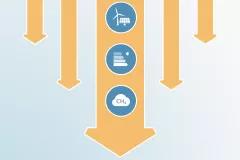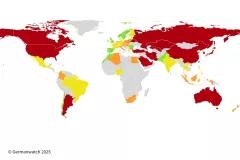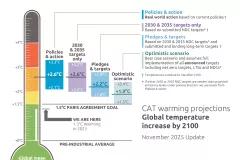Government climate action would see warming well beyond 2˚C
The climate targets so far submitted to the UN by governments collectively lead to global emissions far above the levels needed to hold warming to below 2°C, the Climate Action Tracker said today.
The analysis by the consortium of four research organisations was released today in Bonn where Governments are meeting for the second to last week of negotiations ahead of Paris. Around 65% of global emissions are covered by the “Intended Nationally Determined Contributions” (INDCs) submitted by 29 Governments as of 1 September 2015. The CAT has assessed 15 of these INDCs, covering 64.5% of global emissions, and has rated seven as “inadequate,” six “medium” and only two as “sufficient” (see notes below). The CAT analysis shows that in order to hold global warming below 2˚C, governments need to significantly strengthen the INDCs they have submitted to date: they need to collectively reduce global emissions by a further 12-15 GtO2e by 2025, and 17-21 GtCO2e by 2030. The projected emissions pathway from the combined INDCs also show a very different situation in 2025 than in 2030. If the current 2030 INDCs are locked in, holding warming below 2˚C would become almost infeasible, as CO2 emission reduction rates would need to exceed 5% a year after 2030, and would make holding warming below 1.5˚C almost impossible.
“It is clear that if the Paris meeting locks in present climate commitments for 2030, holding warming below 2˚C could essentially become infeasible, and 1.5˚C beyond reach. Given the present level of pledged climate action, commitments should only be made until 2025,” said Bill Hare of Climate Analytics. “The INDCs therefore need to be considerably strengthened for the period 2020-2025.”
There has been little change in projected aggregate emissions under INDCs since the CAT projected warming of 2.9-3.1˚C in Lima in December 2014, despite the number of INDCs having been submitted this year. The CAT Lima projection included the draft INDCs of the US, the EU and China, which together account for 51% of global emissions. The additional INDCs only cover another 15% of global emissions.
“One would have expected all the new Government climate targets combined to put the world on a lower emissions pathway, but they haven’t. One contributing factor is the fact that Russia, Canada, and New Zealand’s INDCs are inconsistent with their stated long term (2050) goals,” said Louise Jeffery of the Potsdam Institute for Climate Impact Research.
The CAT also found that, in most cases, the policies governments have in place now would not reduce emissions enough to match their INDCs for 2025. The exceptions are China and the EU, who would have to implement minimal extra policies to meet their targets, and could exceed them.
“With current policies being insufficient to limit emissions even to the INDC levels by 2025, it is clear that ramping up greater policy action needs to be encouraged as part of the Paris Agreement,” said Professor Kornelis Blok of Ecofys. “Most governments that have already submitted an INDC need to review their targets in light of the global goal and, in most cases, will need to strengthen them. Those still working on their targets need to ensure they aim as high as possible,” said Niklas Höhne of NewClimate Institute.
The next ten highest emitters yet to submit INDCs are India, Brazil, Iran, Indonesia, Saudi Arabia, South Africa, Thailand, Turkey, Ukraine, and Pakistan, together accounting for 18% of remaining global emissions not yet covered by INDCs (excluding LULUCF).
Go to Climate Action Tracker







